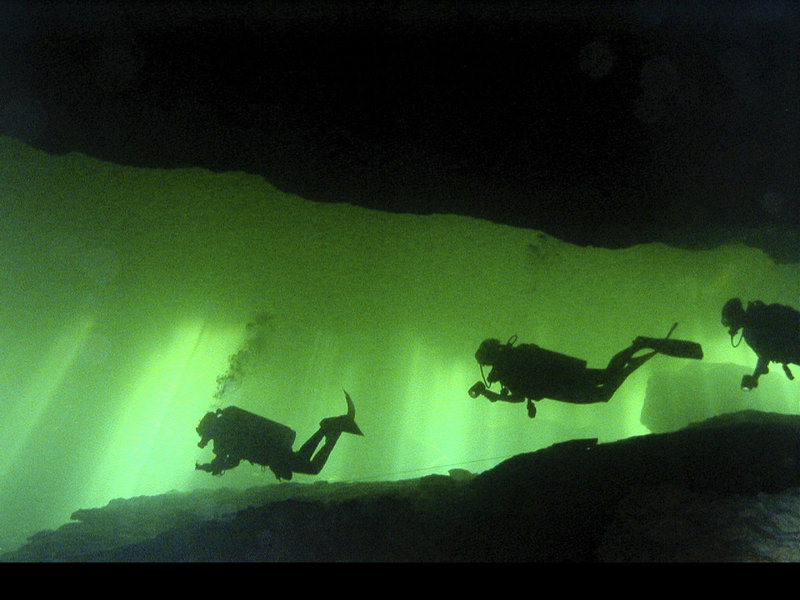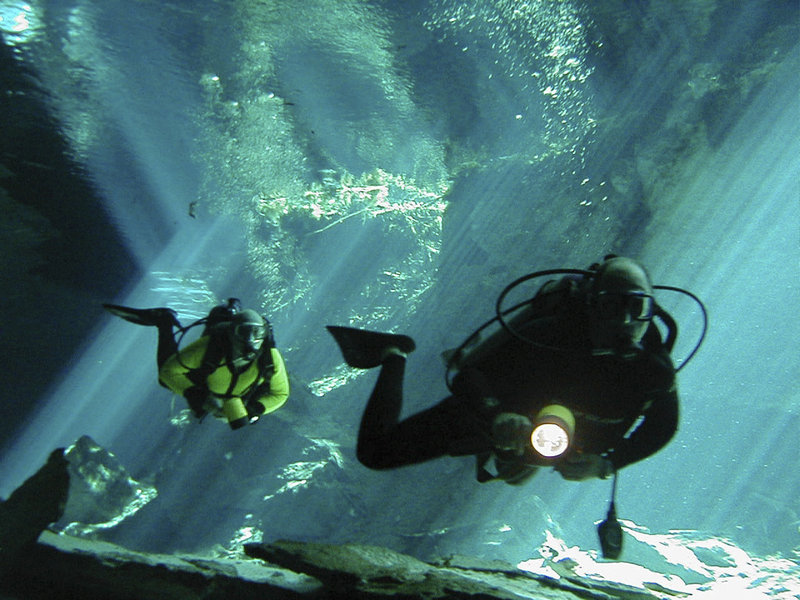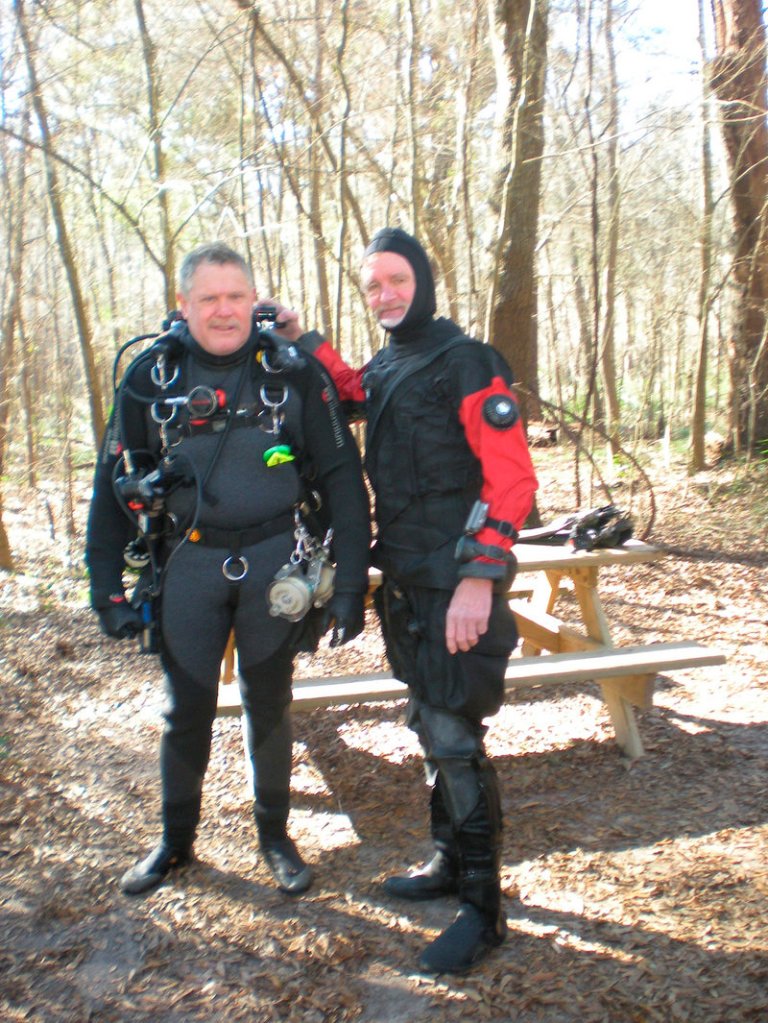WATERVILLE – Stephen Klinker could have died several times while diving in dark, constricted underwater caves.
There was the time when both of his calves cramped up and he could no longer propel himself. He inflated a flotation device until it carried him up, where he could grab the cave’s ceiling and work his calves until his legs could function.
Or the time he got tangled in rope, flipped upside down and his arm sank into quicksand-like silt and mud. Knowing he would be sucked in deeper with the slightest movement, he sent a distress signal and remained completely limp until his instructor could help free him.
Despite the close calls — and, in a way, because of them — Klinker relishes the challenge of cave diving. “Panic is not an option,” he said. “This is a mind-over-matter situation.”
Klinker, 54, lives in Norridgewock and owns Cornerstone Dental in Waterville. He is married and has four sons. He received his cave diving certification from one of the world’s experts on Jan. 16, after completing the last of two required “perfect” cave dives.
Cave diving is a relatively recent phenomenon, becoming popular only within the last two decades. It is in the public spotlight with this weekend’s release of “Sanctum,” an action-thriller movie from executive producer James Cameron.
The film, based on the experiences of the film’s writer, is about how a storm traps a team of cave divers underground.
The renowned cave diver who instructed Klinker, Larry Green, was an informal adviser to the makers of “Sanctum.” Green literally has written a manual on cave diving.
Speaking this week from the outskirts of Gainesville, Fla., Green said he’s not sure why cave diving has become so popular.
He noted that it can be a deadly endeavor for divers who don’t train properly or use enough caution. Even so, he said it is actually “a very safe sport.”
“It’s that mental and physical responsibility; it’s up to me and nobody else,” Green said.
“Even though it’s an adverse environment, the activity itself is one where you should be in control of the variables that affect your well being — more so than any other activity.”
‘A LIFELONG DREAM’
Klinker has been a scuba diver since his college days.
In 1978, he graduated from Northern Michigan University with degrees in biology and business. He also began scuba diving.
Klinker went on to graduate from the College of Veterinary Medicine at Texas A&M University in 1981, and from the University of Texas College of Dentistry, where he received his doctor of dental surgery degree in 1985.
While at dental school, Klinker was introduced to cave diving when he met Ann Kristovich, who had set a world record for deep diving.
Klinker started a dental practice in Austin, Texas, but continued to entertain thoughts of cave diving.
“I had a young family and no money to do it,” he said. “It’s been a lifelong dream to become a cave diver.”
He started taking steps toward that dream six years ago, when he began diving in cenotes — sinkholes with exposed rocky edges containing groundwater — in Mexico.
When he and his family visited Maine, they were so taken with the state that they decided to move here. He opened Cornerstone Dental in 2008.
Shortly after, Klinker began pursuing cave diving more seriously.
There are five certified levels, he said: cavern, basic cave, introduction to cave, apprentice cave diving, and full cave certification.
In open water, divers who have problems have a solution: get to the surface. Deep inside a cave, that’s not an option.
“If you make a mistake, you don’t come out,” he said. “There’s no recovery.”
THE PERFECT DIVES
With his Mexico training to draw on, Klinker began traveling to Florida to study under Green, who is training director for the National Association For Cave Diving.
Klinker soon learned that the caves of Mexico were not nearly as challenging as those in Florida, where the water is colder, the caves contain more silt and mud, the cave routes are tighter and there were powerful currents.
“Even though I had one year of training, it was almost like starting over,” he said.
Cave Diving requires immense preparation and commitment, Klinker said. Cave divers carry much more gear than recreational divers; their equipment can weigh more than 150 pounds and include multiple lights, a helmet, and two air tanks.
Klinker’s extensive training included being blind-folded underwater, tangled in rope and forced to free himself.
He also had to dive as far as he could down narrow cave openings until he could go no farther, then back up.
“Part of the training is trying to confuse you through task-loading,” Klinker said. “You find out where the panic level is, trigger it, and they teach you to get over it, or discontinue the training.”
Preparing for a cave dive typically takes about two hours, involving briefings, cave maps and safety drills.
Klinker also draws cave routes on arm slates, and wears computer devices that monitor his vital signs.
Overall, the idea is to prepare divers to be in complete control of their minds and bodies.
That’s necessary to dive through technically challenging caves, where the slightest touch with anything could spell disaster. Divers must maintain balance and be able to move up, down, left and right, through the tiniest spaces.
Divers go in one way and come out the same way, though the path inside sometimes splinters into many optional routes.
It’s not for the claustrophobic. In fact, it’s not for most people on the planet.
About 95 percent of divers who want to become cave divers fail, according to most cave diving literature.
Klinker says divers who perish in the caves usually don’t use a continuous line to guide them out, don’t bring enough lights, don’t properly watch their air consumption, or don’t properly train for problematic situations and, as a result, panic.
There are an estimated 20 deaths worldwide each year from cave diving.
The U.S. National Speleological Society, a nonprofit organization that studies and protects caves, has defined a successful cave dive as “one you return from.”
The culmination of Klinker’s training — after several failed attempts — was two dives that Green deemed “perfect.”
RETURNING TO THE CAVES
You see some amazing things when cave diving, Klinker says.
Once, Klinker saw the remains of a human skull that had also been seen by a National Geographic team and was deemed among the oldest human remains on Earth.
He has seen a perfectly preserved Mayan pot that had been seen by only a handful of divers because of its remote location.
And a whole skeleton of a mastodon. Yes, the large, tusked, extinct mammal.
It’s that kind of experience that keeps Klinker going back to the caves.
For most everyone, though, he offers this advice about cave diving:
“I don’t recommended it.”
Send questions/comments to the editors.





Success. Please wait for the page to reload. If the page does not reload within 5 seconds, please refresh the page.
Enter your email and password to access comments.
Hi, to comment on stories you must . This profile is in addition to your subscription and website login.
Already have a commenting profile? .
Invalid username/password.
Please check your email to confirm and complete your registration.
Only subscribers are eligible to post comments. Please subscribe or login first for digital access. Here’s why.
Use the form below to reset your password. When you've submitted your account email, we will send an email with a reset code.